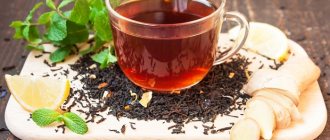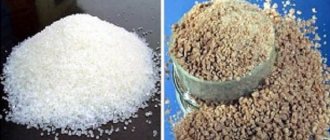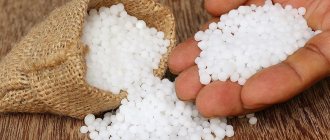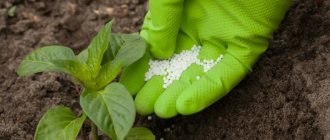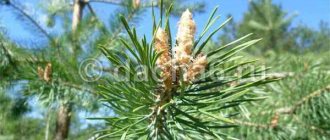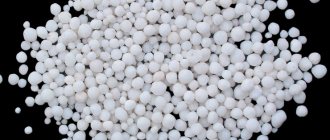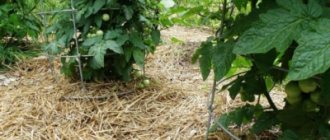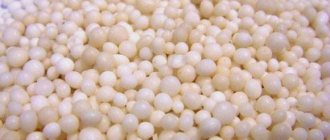For a person unfamiliar with gardening chores, the word “nitrophoska” evokes associations with something toxic: paint and varnish material or poison. In fact, nitrophoska is a fertilizer.
And the word encodes the main macronutrients, without which neither tomatoes, nor potatoes, nor strawberries grow:
- nitro - as in other fertilizers containing this combination of letters, the nitrogen component comes first;
- phos - this part of the word indicates the presence of phosphorus in the composition;
- ka - the third component of NPK (fertility formula) - potassium.
How nitrophoska works, its use in the garden and in the garden, how it differs from complex mineral fertilizers similar in name is the topic of this article.
Composition and varieties
The main ingredients of fertilizer - NPK - is the skeleton of the chemical formula. In any variety, and they are distinguished by percentage and method of preparation, these components are necessarily present. But their share in the total composition may be different:
- 16:16:16 - standard, the most common option with an equal percentage of components;
- 10:10:10 - also a balanced complex, but the concentration is less;
- 11:10:11 - this option contains nitrogen and potassium equally, and slightly less phosphorus;
- 14:15:14 - on the contrary, the proportion of phosphorus is increased;
- 15:10:15:2 - this variety is chosen for drip irrigation combined with fertilizing; the last number in the formula is magnesium.
Variability is necessary for gardeners to choose the most optimal fertilizer composition for:
- specific soil. A complex with a smaller amount of this macroelement is added to soil rich in phosphorus;
- taking into account cultural needs. Tomatoes simply need phosphorus, and if the soil is poor in macronutrients, then nitrophoska, the composition of which is enhanced with phosphorus, is relevant.
A distinctive feature of complex fertilizers is that nitrogen begins to be absorbed by the root system of plants after 2-4 days. And phosphorus-potassium components reach an accessible state only after 2 weeks. This is a huge plus, since at the initial stage of the growing season it is nitrogen that is important for growth.
How to measure the amount of fertilizer
To make it easier for you to prepare nutritional mixtures from nitrophoska, we have written how many grams of the drug are contained in the most common containers: a tablespoon and a teaspoon, and in a matchbox.
How many grams of nitrophoska in a tablespoon
One tablespoon contains 15 grams of nitrophoska granules.
How many grams of nitrophoska in a teaspoon
A teaspoon contains 3 times less fertilizer - only 5 grams.
How many grams of nitrophoska in a matchbox
One matchbox contains 20 grams of granules of this drug.
Types by production method
The manufacturing process for a complex mineral complex is divided into three main stages. The first is common to all varieties. At this stage, from phosphate raw materials treated with nitric acid, a substance is obtained containing:
- calcium nitrate;
- monocalcium phosphate;
- dicalcium phosphate.
If ammonium sulfate is introduced at the second stage, and potassium chloride is introduced at the third stage, then the result after drying and granulation is sulfate nitrophoska . It contains microelements: sulfur, calcium. And this fertilizer is used more often for roses, tulips, petunias, ornamental shrubs, and lawns.
When ammonia and sulfuric acid with magnesium salts are introduced, and then the same potassium chloride, the output is nitrophosphate sulfate . It is more relevant for beds with:
- cucumbers, beans;
- tomatoes, cabbage;
- onions and garlic.
Applying fertilizer with sulfur will not only feed the plant with the necessary elements, but will also repel pests, and it will be easier for the vegetable crop to cope with bad weather - rain, sudden changes in temperature.
If at the second stage of the technical process you replace phosphoric sulfuric acid and finish it again with calcium chloride, you will get nitrophoska phosphorite . This will bring maximum benefit on heavy loams or sod-podzolic soils: it will stimulate flowering and fruit set, and extend the harvest time.
Among the crops that respond especially gratefully to the application of phosphorite nitrophoska are:
- root vegetables - carrots, beets;
- nightshades - potatoes, eggplants, tomatoes, peppers;
- cucumbers
Compatibility of nitrophoska with other fertilizers table
In the table we have provided you with information about the compatibility and incompatibility of nitrophoska with other mineral and organic fertilizers.
Nitrophoska compatibility table
| Compatible | Incompatible |
| Ammonium sulfate | Chicken droppings |
| Ammophos | Ash |
| Calcium nitrate | Manure |
| Ammonium nitrate | Bordeaux mixture |
| Potassium nitrate | Lime |
Description of the fertilizer
The main macroelements in the percentage indicated on the packaging, and microelements obtained by different manufacturing methods are the characteristics of each of the granules.
If we step back from chemistry and move on to physical parameters, then nitrophoska is:
- highly soluble granules of white or bluish color;
- each pea - up to 6 mm;
- the coating guarantees that, subject to humidity (up to 60%), during storage the granules will not stick together and will not lose their shape and properties;
- in warehouses, cottages, packaging with nitrophoska cannot be left in the open sun or near a fire or heater. The drug is explosive and flammable, but spontaneous combustion is excluded in a cool, dark room;
- The shelf life, like many complexes with nitrogen, is short - up to six months, since this macroelement quickly loses its strength in air and evaporates.
It is not recommended to apply fertilizer in the fall: by spring, phosphorus and potassium will be preserved and will begin to work, but there will be no trace of nitrogen left.
How to improve the condition of the land
Urea or carbamide: composition and methods of using fertilizer in the garden for vegetables and berries and fruit trees
Immediately after harvesting, begin preparing the beds for next year. Even if autumn is still far away, remove unnecessary tops and, if possible, pull out weeds by the roots.
As soon as September arrives, and in the southern regions October, you can begin to improve the soil:
- Carefully inspect the area, remove all weeds with seeds.
- Burn all biomaterials or put them in a composter.
- Apply fertilizer according to regulations.
- Dig up the soil.
- If autumn turns out to be dry, water the beds.
In autumn, it is good to monitor the acidity of the soil. The easiest way to do this is to use indicator strips or take the materials and send them to the laboratory. The reaction should be slightly acidic - many plants grow poorly in alkaline soils.
If you have predominantly acidic soil, autumn is the time to start working to neutralize the acidity. For this purpose, lime or dolomite flour is added according to the developed standards (listed in the table).
| Soil acidity (pH) | Clay soil (g/m2) | Sandy soil (g/m2) |
| Less than 4 | 500-600 | 300-400 |
| 4,1-4,5 | 400-500 | 250-300 |
| 4,6- 5,0 | 300-400 | 200-400 |
Mineral fertilizers are also applied in the fall. Their number depends on what crop is planned to be grown in the future. Standardly, per square meter you need 25 g of urea, 20 g of superphosphate, and the same amount of potassium chloride. Organic matter is also added - humus or compost in an amount of 4-5 kg per square meter.
Heavy soils are usually not suitable for plants; moisture is poorly absorbed; when watering, a crust immediately forms, and therefore loosening is necessary. The structure of the soil can be improved if in the fall you add 1-2 kg of washed river sand per square meter.
The main thing is not to overdo it, because sandy loam soils are also not very suitable for plants. We have to fight them in another direction - to increase moisture capacity. To do this, you need to systematically add leaf humus or compost.
You can also scatter rotted sawdust, but fresh sawdust is not suitable for this purpose; it absorbs nitrogen and does not allow plants to develop.
The rates of fertilization in autumn for different crops can be found in the table.
| Culture | Fertilizer application rate per m2 | ||||
| Urea | Humus | Superphosphate | Ash | Potassium sulfate | |
| Garlic | — | 10 kg | 1 tbsp spoon | 400 g | 2 tbsp |
| Onion | 1 tsp. | 4 kg | 1 tbsp. l | 200 g | — |
| Carrot | — | 5 kg | 1 tbsp. l. | 300 g | — |
| Eggplant | — | 4 kg | 60 g | — | 60 g |
| Cabbage | — | — | 30 g | 200 g | 50 g |
| Peppers | — | 5-6 kg | — | — | — |
| Potato | — | 6-10 kg | 40-45 g | 0.5 kg | 15-20 g |
| Zucchini | — | 4-6 kg | 30-35 g | — | 15-20 g |
| Beet | — | — | 20-25 g | — | 20-25 g |
| Tomato | — | 4-6 kg | 40-50 g | 200 g | — |
| cucumbers | — | 7 kg | 50-60 g | — | — |
| Strawberry (Victoria) | 25 g | 10 kg | 40 g | — | — |
| Raspberries | — | 7 kg | 20 g | — | — |
Norms may vary depending on the composition of the soil, so see the instructions for each crop.
How to use
The popular complex fertilizer is applied in early spring when the soil is first prepared for vegetable and garden crops, or directly into the hole with granules before planting. In the summer, plants are fed with an aqueous solution of nitrophoska - by watering or foliar treatments.
On a note! The method of applying mineral fertilizers for the purpose of summer feeding is chosen according to the weather.
- if it has been hot for a long time, first water the plants, then either seal the granules or treat the soil with an aqueous solution;
- during rains only granules are applied.
It is recommended to use nitrophoska no more than 3 times:
- pre-planting general preparation of the site or directly into the hole;
- during the formation of buds, at the height of flowering;
- When the flowers fall off, the fruits begin to set.
Instructions for use recommend taking into account the application rate for each type of plant. Dosages depend on the growing season and method of application:
- in the fall, digging up the area completely, add 80 g of nitrophoska, distributing this dose per 1 square meter. meter of area;
- in the spring when planting - in the hole, observing the dosages indicated in the table.
| Plant | Quantity in grams | Quantity per table. spoons |
| cucumbers | 35 | 2 (plus tea room) |
| Tomatoes and other nightshades | 15 | 1 |
| Potato | 15 | 1 |
| Strawberry | 30 | 2 |
How to determine that plants need to be fed with nitrophoska
The need to use the drug is determined by the appearance of the plants:
- Weak growth of crops, thin shoots, pale or yellowish leaves, absence of apical buds, small inflorescences - all this indicates a lack of nitrogen.
- Slow growth, weak immunity, and frequent illnesses indicate a deficiency of potassium, which stimulates photosynthesis processes.
- Poor quality of fruits, poor germination of seeds, deformation of shoots and fruits, change in leaf color to purple-red are signs of phosphorus deficiency. This element is important for the taste of the fruit.
ON A NOTE. You should also use the drug if your site has poor or heavy soils with low yields. Then the applied fertilizer enriches the soil with the necessary components.
Dry feeding of perennials
The initial stage of the growing season requires the application of fertilizers to overwintered fruit, berry, ornamental crops, and winter plantings. To do this, holes and grooves are made in the tree trunk circle and between the rows. If the soil has dried out, water it lightly, add granules, and cover it up.
Norms (grams):
- mature fruit-bearing apple trees, pears, plums - 400;
- young trees - 200;
- ornamental, berry bushes, grapes - 150;
- raspberries, blackberries - 50;
- strawberry - 40.
After applying the fertilizer, the soil is watered.
How to increase the fertility of the land on the site?
They also add other organic and mineral complexes that help enrich the soil with useful substances and increase fertility. Gardeners add sawdust as a loosening agent for heavy soils, as well as to create flora for the development of microorganisms and earthworms. With their regular application, the soil will acquire a dark color and accumulate humus.
Organic fertilizer
Peat retains moisture well, but nutrient levels are low. Therefore, in the fall it is applied in the form of compost. Components of compost using peat can be horse manure, mullein, litter, ash, tops of weeds of cultivated plants. It is prepared in a layered manner: 20 cm of manure (or other raw materials) and 10 cm of peat. The height of the pile is made up to a meter, covered with film or other moisture-resistant material and left to rot for a year. The use of compost helps create a fertile soil layer that is nutritious for any type of plant for the entire season. Spread it in a dense layer of 4 kg per 1 square meter. m and plowed into the ground.
September and October are the months when the main crops are harvested. The land is empty, and at this time, zealous owners plant the plots with siderites: rapeseed, mustard, Shrovetide radish, lupine. In the fall, it is more effective to plant mustard, since it has low temperature requirements (the development and growth of the plant occurs even at a temperature of 2-4 degrees). Mustard also fights stalks, slugs and wireworms and clears the ground of weeds. During the plowing period, quickly growing greenery gets into the soil and enriches it.
Fertilizers obtained by mixing various chemical components are called complex or combined. They already contain the necessary microelements in varying proportions. These include: ammophos, potassium nitrate, ammonium and potassium polyphosphates, etc.
Combined soil fertilizers
Liquid fertilizers
Since the granules are quickly and easily soluble, root feeding is not difficult. It is worth considering: if mineral fertilizers were applied during planting, then organic or folk remedies are used to first feed the plants. It will not lead to the accumulation of nitrates in fruits and will give maximum effect by alternating chemicals with organics.
In the dosage table for a 10-liter bucket of water heated in the sun:
| Plant | Quantity in grams/volume of watering 1 plant | Alternative way to measure |
| Mature apple trees, cherries, and other fruit trees | 50/20 l | 2.5 matchboxes/3 tbsp. |
| Currants, gooseberries | 40/10 l | 2 matches box/2 tbsp. |
| cucumbers | 40/0.5 l | Also |
| Tomatoes | 50/0.5 l | 2.5 matches box/3 tbsp. |
| Eggplant | 20/0.5 l | 1 box/1 tbsp. + 1 tsp. |
| Garlic (only in spring and summer), onions, root vegetables | 30/0.3 l | 2 tbsp. |
For leaf treatment, use half the dose. Irrigate only early in the morning or evening.
For seedlings
If the planting soil is not nutritious enough, then after picking (a week later) and before planting in the garden bed, young plants are fed into the greenhouse, including nitrophoska, at the rate of:
- 1 liter of warm water;
- 0.5 teaspoon of granules;
- watering over a moistened substrate.
If mineral or organic fertilizers were not used during planting, then a week after planting, watering is repeated in the same concentration.
Indoor flowers
Household ornamental plants are fed with liquid nitrophoska in the spring: 3 tbsp. spoons are dissolved in a 10-liter container of water. For the second half of the active growing season, fertilizers without nitrogen are selected, which stimulates further growth, when the accumulation of resources for dormancy is already required.
Using nitrophoska as a fertilizer in spring
In the spring, when the dacha season begins, the drug is used to saturate the soil with nutrients needed for upcoming plantings.
The fertilizer is scattered over the entire area of the site, after which it is plowed or dug up. The granules remain in the soil, where they dissolve and saturate the soil with useful microelements.
Fertilizing is very useful, because it improves the structure and mineral composition of the soil. The soil is enriched with useful microelements.
Due to nitrophoska, cultivated plants better tolerate planting in a permanent place in a greenhouse or open ground, begin to grow faster and subsequently form high-quality ovaries.
Per square meter of soil for future plantings you need 70 grams of the product. The drug must be embedded in the soil or watered abundantly. Liquid is needed to dissolve the granules and release mineral compounds.
The product is also actively used when transplanting seedlings and sowing seeds. In this case, the granules are placed on the bottom of the hole, grooves and planting holes. At the same time, remember that there must be at least a small layer of soil between the fertilizer and the roots of the plant so that the roots do not receive a chemical burn.
The third method of spring application is preparing a liquid solution for feeding perennial plantings.
Advantages and disadvantages
Gardeners like nitrophoska because:
- the price for 1 kg rarely exceeds 60 rubles;
- convenient packaging;
- has good solubility (no sediment);
- easy to dilute, easy to use;
- There are dosages for different crops;
- used on any soil, for all crops.
Among the disadvantages of nitrophoska:
- short shelf life;
- rapid loss of properties in opened packaging;
- the risk of overdose is the accumulation of nitrates.
Advantages and disadvantages
If you plan to use it for tomatoes, nitroammophoska should be considered in comparison of the advantages and disadvantages that the fertilizer has. Positive properties include:
- the main substances in the composition occupy about 30% of the total amount, which actively stimulates the growth of crops;
- During the shelf life, the composition remains flowable;
- all components are balanced;
- good solubility;
- easy to use;
- Depending on the type of crop, productivity can be increased by 10–70%.
In addition to the advantages that distinguish this fertilizer, it is worth considering some disadvantages before you start using tomato seedlings - nitroammofoska contains exclusively chemical substances and can provoke the accumulation of nitrates in the soil. If chemicals are used incorrectly, the crop will contain harmful levels of nitrates. The shelf life of the composition is no longer than six months. The substance is highly flammable and is classified as explosive, which dictates special storage rules.
Consonant fertilizers: generalities and differences
In stores, the gardener sees many drugs whose names contain the same part of the word: “phos”.
The composition and purpose of the products are almost similar. For example, the difference between nitrophoska and nitroammophoska (in the photo) is only that in the first nitrogen is contained in the nitrate state, and in the second it is also in the ammonium state.
Complex complexes:
- ammophoska;
- azophoska;
- nitroammophoska;
- Diammophoska.
In spring, complex fertilizers are replaced with single-component ones:
- carbamide (urea);
- superphosphate;
- potassium nitrate.
In country and industrial gardening, different fertilizers are used. The effectiveness of use directly depends on following the instructions. Knowing why and when a crop needs a drug, having studied the description of the method of action on soil and plants, understanding the differences in compositions, we achieve maximum yield without harm to the land, fruits, or health.
Nitrophoska or nitroammofoska
Before purchasing fertilizers, gardeners need to understand what types of fertilizers exist and how they differ from each other. Most often, it is recommended to apply nitrophoska and nitroammophoska to tomatoes. These fertilizers are able to saturate plants with essential nutrients. The results of their use are visible almost immediately. The cost of fertilizing depends on the composition, concentration of substances contained, and the manufacturer’s pricing policy.
One of the most famous types of fertilizers is nitrophoska. The basis of the fertilizer is a complex of elements necessary for tomatoes:
- nitrogen;
- potassium;
- phosphorus.
They are included in the composition in the form of salts. The ratio of these components may vary. If a gardener plans to scatter fertilizers over the beds in dry form, then it is better to give preference to the option in which the active ingredients are in equal quantities. The ratio of nitrogen, phosphorus and potassium is 16:16:16.
If a summer resident is going to water the tomatoes with a fertilizer solution, it is recommended to use a nitrophoska containing magnesium. The ratio of the main components will be as follows:
- nitrogen 15%;
- phosphorus 10%;
- potassium 15%;
- magnesium 2%.
Attention!
In terms of chemical properties and mechanism of action on tomatoes, nitrophosk and nitroammophoska are similar. Nitroammophoska contains similar components. But fertilizer differs from nitrophoska in the concentration of substances included in the composition and their form. The nitrate form of nitrogen is included in nitrophoska. It is easily accessible to plants. But fertilizers are washed out of the soil just as quickly. Nitroammophoska contains the ammonium form of nitrogen. Thanks to its presence, the validity period of the fertilizing is extended.
You can distinguish nitrophoska from nitroammophoska by color. Typically, nitrophoska granules are white, sometimes they have a bluish tint. Pink nitroammophoska granules. These substances also differ in the method of use. When using nitrophosphate to fertilize tomatoes, it is necessary to apply it in a concentration 1.5 times higher than nitroammophosphate.
Reviews
Ivan Novikov, Transbaikalia
I use nitrophoska in the garden every year in the spring. Our summer season is short, so we need an active start. The drug is easy to dilute, and if you follow the rules, then there is no harm, only benefit. In the summer - organic, and in the fall again chemistry. The earth gives its strength to the harvest, so we need to help the soil recover.
Irina Sotnikova, Moscow region
It is impossible to do without mineral fertilizers, so the use of chemicals within reasonable limits is necessary. I add nitrophoska when planting. Once the plant has gained strength, I feed it with herbal infusions; mineral water is no longer required.
Answers to frequently asked questions
When can nitrophoska be used in the garden?
Throughout the entire summer season, from digging the soil to the formation of fruits. But the remedy is most effective in spring and early summer.
Can I use flower spray?
Yes, including those at home.
How to apply fertilizer so that it is effective?
In the spring, scatter it over the area before plowing or digging the ground, and place it in holes and furrows when planting crops. In the summer, liquid compositions for root and foliar application are prepared from nitrophoska.
Precautionary measures
Before use, protect yourself with personal protective equipment - a respirator and gloves. Although NPK has little toxicity, contact with the mucous membrane leads to burns, and inhalation of the drug provokes severe intoxication and even an allergic reaction in the form of Quincke's edema.
It is prohibited to allow children and animals near the nitroammophoska. After finishing work, you must wash your face and hands with laundry soap, because some of the chemical may be carried by the wind.
In addition, the substance is dangerous due to its effect on the earth and plants. Its frequent use leads to the accumulation of heavy metals in the soil and the minimization of useful substances. This contributes to reduced growth and yield. Subsequently, consuming fruits with such a composition has a detrimental effect on people's health.
What does it consist of and chemical formula
The base of the combined mineral fertilizer is considered to be an NPK complex, which includes nitrogen, potassium and phosphorus. The percentage of the main ingredients of the composition does not exceed 60%. However, the quantity of each of them is slightly different.
In most cases, you can find a composition on sale in which nitrogen, potassium and phosphorus are present in equal quantities. However, there are species in which an increased content of a certain component is observed. In addition, the drug may contain ammonium nitrate, ammonium chloride and calcium, and potassium nitrate. In addition, nitrophoska contains a little gypsum flour.
The chemical formula of the drug is NH4NO3CaHPO4(NH4)2HPO4Ca+CaSO42H2OKCl. The product contains nitrates, which can be harmful to human health. However, if the dosage and instructions for use of the product are followed, the substance is considered completely safe.
Nitrophoska can be used for all cultivated and ornamental plants, regardless of region. The drug has an affordable price, which is why it is very popular among farmers and summer residents.
